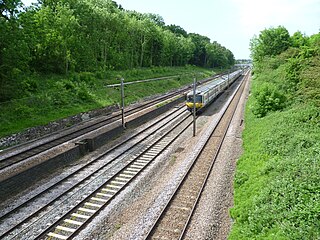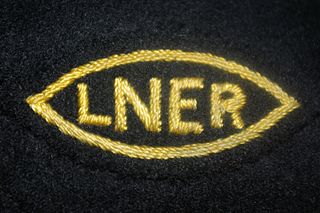
The Northern line is a London Underground line that runs from south-west to north-west London, with two branches through central London and three in the north. It runs northwards from its southern terminus at Morden in the borough of Merton to Kennington in Southwark, where it divides into two central branches, one via Charing Cross in the West End and the other via Bank in the City. The central branches re-join at Camden Town where the line again divides into two branches, one to High Barnet and the other to Edgware in the borough of Barnet. On the High Barnet branch there is a short single-track branch to Mill Hill East only.

The Northern City Line is a commuter line in England, which runs from London Moorgate to Finsbury Park in London with services running beyond. It is part of the Great Northern Route services, and operates as the south-eastern branch of the East Coast Main Line (ECML). It is underground from Moorgate to Drayton Park in Highbury, from which point it runs in a cutting until joining the ECML south of Finsbury Park. Its stations span northern inner districts of Greater London southwards to the City of London, the UK's main financial centre. Since December 2015, its service timetable has been extended to run into the late evenings and at weekends, meeting a new franchise commitment for a minimum of six trains per hour until 23:59 on weekdays and four trains per hour at weekends.

East Finchley is a London Underground station in East Finchley in the London Borough of Barnet, north London. The station is on the High Barnet branch of the Northern line, between Highgate and Finchley Central stations and is in Travelcard Zone 3.

East Barnet is an area of north London within the London Borough of Barnet bordered by New Barnet, Cockfosters and Southgate. It is a largely residential suburb whose central area contains shops, public houses, restaurants and services, and the parish church of St Mary the Virgin. East Barnet is close to the M25 and the A1 and M1.

Arnos Grove is a London Underground station located in Arnos Grove in the London Borough of Enfield, London. It is on the Piccadilly line between Bounds Green and Southgate stations and is in Travelcard Zone 4. The station opened on 19 September 1932 as the most northerly station on the first section of the Piccadilly line extension from Finsbury Park to Cockfosters. It was the terminus of the line until services were further extended to Oakwood on 13 March 1933. When travelling from east of Barons Court and through Central London, Arnos Grove is the first surface station after the long tunnel section of the Piccadilly line. The station has four platforms which face three tracks.

Finchley Central is a London Underground station in the Church End area of Finchley, north London. The station is on the High Barnet branch of the Northern line, between West Finchley and East Finchley stations, and is the junction for the short branch to Mill Hill East. The station is around 7 miles north-northwest of Charing Cross and is in Travelcard Zone 4.

Totteridge & Whetstone is a London Underground station in Whetstone of the London Borough of Barnet, North London. The station is the penultimate one on the High Barnet branch of the Northern line, between Woodside Park and High Barnet stations, in Travelcard Zone 4. It was first built in 1872.

The Edgware, Highgate and London Railway was a railway in north London. The railway was a precursor of parts of London Underground's Northern line and was, in the 1930s the core of an ambitious expansion plan for that line which was thwarted by the Second World War. Parts of the line were closed in the 1950s and have since been removed.

Stroud Green railway station is a former station in the Stroud Green area of north London. It was located between Finsbury Park station and Crouch End station on a bridge over Stapleton Hall Road. The station had platforms cantilevered from the bridge structure and a wooden station building at ground level under and on either side of the bridge, with a station master's house to the north of it. The bridge still exists, and now carries the Parkland Walk cycle and pedestrian path, whilst the station master's house serves as a community centre.

Brunswick Park is a populous neighbourhood and public park/set of small sports grounds in the London Borough of Barnet. It is north of New Southgate and to the south of Oakleigh Park.

The Piccadilly line extension to Cockfosters added eight new stations to the northern end of London Underground's Piccadilly line. The extension through north London from Finsbury Park to Cockfosters was opened in three stages between 19 September 1932 and 31 July 1933.

The area around Hornsey railway station in Hornsey has been the site of several railway maintenance facilities from the mid 19th century onwards.

The Dudding Hill Line is a railway line in north-west London running from Acton to Cricklewood. The line has no scheduled passenger service, no stations, no electrification, and a 30 miles per hour (48 km/h) speed limit with semaphore signalling, and is lightly used by freight and very occasional passenger charter trains. It is roughly 4 miles (6.4 km) long.

New Southgate Cemetery is a 22-hectare cemetery in New Southgate in the London Borough of Barnet. It was established by the Colney Hatch Company in the 1850s and became the Great Northern London Cemetery, with a railway service running from near Kings Cross station to a dedicated station at the cemetery, similar to the service of the London Necropolis Company to Brookwood Cemetery in Surrey.

The Northern line Embankment between Totteridge and Whetstone and High Barnet tube stations on the Northern line is a Site of Borough Importance for Nature Conservation, Grade II, in the London Borough of Barnet.

Oakleigh Park Rail Cutting is an 8 hectare Site of Local Importance for Nature Conservation in Oakleigh Park in the London Borough of Barnet. It is on the East Coast Main Line between Oakleigh Park railway station and Barnet Tunnel to its south.

























